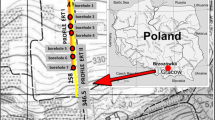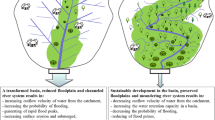Abstract
During a short-term recent period (about 50 years), many floodplains of the Nonchernozemic zone were used as meadows, croplands for growing row crops, or they were abandoned. This was done to supply the populations of industrial cities with vegetables. In this case, the agrotechnical, ameliorative, and some other measures applied were often incompatible with the properties of the floodplain soils and caused their degradation. Among these measures was the elimination of grasses in the crop rotation, the monoculture of row crops, inadequate irrigation inducing systematic waterlogging, and the wide use of heavy agricultural machines. The consequences of using such technologies were investigated by the authors; on these soils, row crop were grown for 30 years and, for the next 20 years, the soils were left under fallow. Based on the data obtained, methods for the floodplain soils’ protection against degradation are proposed.
Similar content being viewed by others
References
G. V. Afanas’ev, “Particle-size distribution in soils of the Moskva River floodplain in the area of Faustovo farm,” Dokl. Mosk. S-Kh. Akad. Im. K.A. Timiryazeva, No. 29, 15–17 (1957).
P. N. Balabko, N. A. Muromtsev, and E. A. Stytsina, “Changes in the morphology and physical properties of alluvial soils of the Moskva River floodplains under conditions of strong anthropogenic impacts,” in Scientific Fundamentals of Fertility Optimization in Alluvial Soils of the Nonchernozemic Zone (Moscow, 1991), pp. 35–44 [in Russian].
G. P. Bondarenko, “Seasonal dynamics of mobile forms of microelements and iron in floodplain soils of the Moskva River in Ramenki area,” Nauchn. Dokl. Vyssh. Shkoly, Ser. Biol., No. 4, 202–207 (1962).
S. N. Borshtein, “Reaction and water and nutrient regimes of floodplain soils of the Moskva River in the area of Faustovo farm,” Dokl. Mosk. S-Kh. Akad. Im. K.A. Timiryazeva, No. 1, 10–12 (1951).
V. D. Bykov, Moskva River (Moscow, 1951) [in Russian].
A. F. Vadyunina and Z. A. Korchagina, Methods for Studying Soil Physical Properties (Agropromizdat, Moscow, 1986) [in Russian].
E. T. Golovina, Extended Abstract of Candidate’s Dissertation in Biology (Moscow, 1957).
L. I. Grinenko, “The content of mobile manganese in relation to the water and air regimes of mineral floodplain soils of the Moskva River floodplain,” Pochvovedenie, No. 10, 18–21 (1956).
G. V. Dobrovol’skii, Soils of Floodplains in the Central Part of the Russian Plain (Izd. Mosk. Gos. Univ., Moscow, 1968) [in Russian].
T. I. Evdokimova and L. A. Grishina, “Soils of the Moskva River valley in its lower reaches,” in Floodplain Soils of the Russian Plain (Izd. Mosk. Gos. Univ., Moscow, 1963), pp. 3–26 [in Russian].
T. I. Evdokimova and L. A. Rudina, “The role of herbaceous vegetation in soil formation on the Moskva River floodplain,” Pochvovedenie, No. 9, 80–89 (1958).
F. R. Zaidel’man, “Water regime and physical properties of swampy floodplain soils in the southern part of the taiga zone,” Pochvovedenie, No. 4, 5–19 (1963).
F. R. Zaidel’man, Genesis and Ecological Basics of Soil and Landscape Reclamation (Izd. KDU, Moscow, 2009) [in Russian].
F. R. Zaidel’man, Methods of Soil Studies for Reclamation Purposes (Kolos, Moscow, 2008) [in Russian].
F. R. Zaidel’man, “Problems of reclamation of heavy-textures swampy soils of the nonchernozemic zone (analysis of Russian and foreign experience),” Gidrotekh. Melior., No. 12, 62–65 (1974).
F. R. Zaidel’man, Regime and Reclamation of Swampy Soils (Kolos, Moscow, 1975) [in Russian].
F. R. Zaidel’man, Ecological and Hydrological Basics of Deep Soil Loosening for Reclamation Purposes (Moscow, 1986) [in Russian].
F. R. Zaidel’man and M. V. Belichenko, “Effect of drainage and irrigation on physical properties and hydrological regime of agricultural soils in Moscow oblast,” Eur. Soil Sci. 32(11), 1230–1244 (1999).
F. R. Zaidel’man, M. V. Belichenko, and A. S. Nikiforova, “Changes in the chemical properties of flood-plain soils under the impact of drainage, sprinkler irrigation, and agricultural use,” Vestn. Mosk. Univ., Ser. 17: Pochvoved. No. 1, 10–16 (1999).
F. R. Zaidel’man, M. V. Belichenko, and A. D. Pudule, “Changes in the physical properties of floodplain soils under the impact of drainage and irrigation in vegetable rotations,” Vestn. Mosk. Univ. Ser. 17: Pochvoved., No. 1, 36–42 (1997).
F. R. Zaidel’man and A. K. Ogleznev, “A study of gleyzation in swampy alluvial soils of the nochernozemic zone,” Pochvovedenie, No. 1, 44–52 (1963).
L. I. Korableva, “Agrochemical characteristics of soils of the Moskva River floodplain,” Pochvovedenie, No. 4, 30–39 (1961).
L. I. Korableva, Fertility, Agrochemical Properties, and Fertilization of Floodplain Soils in the Nonchernozemic Zone (Nauka, Moscow, 1969) [in Russian].
I. I. Plyusnin and I. A. Bernikovskaya, “Floodplain soils of the first department of the Ramenskii sovkhoz,” Tr. Mosk. Gidromeliorat. Inst. 34, 151–173 (1973).
I. I. Plyusnin, T. A. Lobanova, and I. A. Bernikovskaya, “The impact of high water in the fall and winter on the properties of floodplain soils,” Izv. Timiryazevsk. Sel’skokhoz. Akad., No. 4, 92–110 (1963).
I. I. Plyusnin, T. A. Lobanova, and I. A. Bernikovskaya, “Floodplain soils of the Ramenki widening of the Moskva River valley,” Dokl. TSKhA, No. 50, 75–90 (1960).
Z. A. Prokhorova, “Dynamics of nutrients and redox processes in soils of the Moskva River floodplain,” Pochvovedenie, No. 1, 20–24 (1957).
L. A. Rudina, “Dynamics of water-stable structure in the upper layer of meadow soddy-podzolic soils of the Moskva River floodplain,” Nauchn. Dokl. Vyssh. Shk., Ser. Biol., No. 4, 8–10 (1958).
L. A. Rudina, Extended Abstract of Candidate’s Dissertation in Agriculture (Moscow, 1959).
Theory and Practice of the Chemical Analysis of Soils, Ed. by L. A. Vorob’eva (Geos, Moscow, 2006) [in Russian].
A. N. Tyuryukanov, “On the specificity of the chemical composition of soil and ground water on floodplains and the factors controlling it,” Pochvovedenie, No. 9, 79–88 (1957).
A. N. Tyuryukanov, Extended Abstract of Candidate’s Dissertation in Biology (Moscow, 1956).
V. I. Shrag, Floodplain Soils and Their Reclamation and Agricultural Use (Rossel’khozizdat, Moscow, 1969) [in Russian].
R. Eggel’smann, Manual on Drainage (Kolos, Moscow, 1978) [in Russian].
P. Benecke and M. Renger, “Ergebnisse von felddurchlessigkeitsmessungenmittels der bohrlochmethodenach hooghoudt-ernst,” Z. f. Kulturtechn. u. Flurbereing 10 (1969).
H. Foth, Fundamentals of Soil Science (John Wiley & Sons, 1990).
B. Galic, G. Dugalic, and Z. Sredojevic, “Soil compaction as a consequence of utilization modes,” J. Agric. Sci. 49(2), 179–185 (2004).
Z. Galić, P. Ivanišević, S. Pekeč, M. Kebert, S. Stojnić, “Characteristics of soil types on small river islands in the central Danube basin,” Bull. Faculty Forestry 100, 55–70 (2009).
H. Hanus and H. G. Knoch, “Beitragzur methodik der wasser permeabilitats messung an ungestoren boden proben,” Z. f. Pflanzenern., Dungung Bodenk 111 (1965).
H. Klinge, “Climatic conditions in lowland tropical podzol areas,” Tropical Ecol. Bull., No. 10, 222–239 (1969).
H. Klinge, “Podzol soils: a source of blackwater rivers in Amazonia,” Atas do Simposiosobre a Biota Amazonica 3, 117–125 (1967).
H. Klinge, “Podzol soils in the Amazon basin,” J. Soil Sci. 16, 95–103 (1965).
H. Klinge, Report on Tropical Podzols Unpubl. FAO Report, 1968.
H. Klinge and W. Ohle, “Chemical properties of rivers in the Amazonian area in relation to soil conditions,” Verh. Int. Verein. Theor. Angew. Limnol. 15, 1067–1076 (1964).
L. Lindell, “Environmental effects of agricultural expansion in the upper Amazon,” in A Study of River Basin Geochemistry and Hydrochemistry, and Farmers’ Perceptions (Linnaeus University Press, 2011).
B. Renöfält, “Vegetation Patterns and Processes in Riparian Landscapes” Doctoral Diss., Umea University, Sweden, 2004.
Author information
Authors and Affiliations
Corresponding author
Additional information
Original Russian Text © F.R. Zaidelman, M.V. Belichenko, A.S. Bibin, 2013, published in Pochvovedenie, 2013, No. 11, pp. 1377–1386.
Rights and permissions
About this article
Cite this article
Zaidelman, F.R., Belichenko, M.V. & Bibin, A.S. Degradation and restoration of soils in the Moscow River floodplain for the last fifty years. Eurasian Soil Sc. 46, 1097–1106 (2013). https://doi.org/10.1134/S1064229313110070
Received:
Published:
Issue Date:
DOI: https://doi.org/10.1134/S1064229313110070




